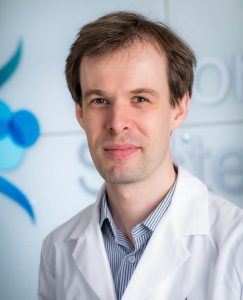Non-Hodgkin lymphoma, one of the most common cancers in the U.S., is often cured with a combination of multiple chemotherapy drugs. Although doctors have been using this strategy for decades, scientists still do not understand why the combination works better than individual drugs.
 Adam Palmer, Ph.D., from the University of North Carolina Lineberger Comprehensive Cancer Center is one of the few scientists working to better understand these drug combinations. With a V Scholar grant, he is combining experiments with computer models of tumor heterogeneity that can predict results for clinical trials of multi-drug treatments. The insights from this work could help doctors optimize treatment regimens for patients and also help scientists find better ways to develop new combination therapies.
Adam Palmer, Ph.D., from the University of North Carolina Lineberger Comprehensive Cancer Center is one of the few scientists working to better understand these drug combinations. With a V Scholar grant, he is combining experiments with computer models of tumor heterogeneity that can predict results for clinical trials of multi-drug treatments. The insights from this work could help doctors optimize treatment regimens for patients and also help scientists find better ways to develop new combination therapies.
“Drug combinations for cancer were developed by trial and error through decades of clinical trials,” said Palmer. “Although we understand the targets of individual drugs, single drugs rarely cure people. The scientific principles behind how approved combinations can achieve cures have been studied very little.”
Making sense of why combination therapies work
In previous studies, Palmer’s research team examined R-CHOP, a five-drug combination used to treat diffuse large B-cell lymphoma, the most common type of non-Hodgkin lymphoma. Scientists have long assumed that drug combinations like R-CHOP work by creating synergies, such that the combined effect is greater than the sum of its parts.
However, Palmer found no evidence for this type of synergy in laboratory experiments with cancer cells. While the drugs did have an additive effect, they did not give each other a more than additive boost when administered together. The mystery deepened when the team discovered that some of the drugs actually interfered with one another’s effects.
“This very much challenged our expectations, because when unfavorable drug interactions are observed in preclinical work today, that combination would not move forward into the clinic,” said Palmer. “And yet we know empirically that R-CHOP can not only cure people but that it’s the best available frontline treatment.”
One possible explanation is that cancer cells are different, or heterogeneous, between and within patients. Perhaps the combination therapy works by compensating for these differences? “Because of heterogeneity, patients who don’t respond to one therapy sometimes do respond to a different therapy,” said Palmer. “The same is true inside a tumor. Some tumor cells may be resistant to one drug while other cells are resistant to a different drug. But if both drugs are used, there might be very few cells that resist both drugs.”
The more complicated question is how heterogeneity plays out with approved combinations of five or more therapies, the number it takes to cure most patients with large B-cell lymphomas. To dig into this, the researchers built a computer simulation of clinical trials involving drug combinations. The model incorporates information from experimentally measured dose responses, drug interactions and resistance between drugs to investigate questions about clinical outcomes that are impossible to answer with laboratory experiments.
When they used the simulation to analyze data from real clinical trials for combination therapies, the simulation’s predictions matched the actual patient outcomes observed in the trials. A simple version of the model has also been applied to combination immunotherapies in a variety of cancers, which found that nearly all FDA-approved combinations of this type were as effective in humans as predicted by their model. This work was published in Clinical Cancer Research.
Forecasting findings
The V Foundation funding allowed the researchers to take this a step further. With a V Scholar grant, Palmer improved the models to not only capture heterogeneity but also simulate the effects of changing the drug dosage, timing, or the number of treatment cycles.
“For aggressive lymphomas, some patients benefit from adding additional chemotherapies or increasing the dose, but some patients need doses lowered to keep the combination tolerable,” said Palmer. “We are now using our model to forecast if a new treatment design is likely to be effective or not for a group of patients, based upon the activity of the individual drugs and what doses are tolerable in the combination.”
After observing negative drug interactions in the R-CHOP combination, the researchers experimentally measured whether lymphoma cells would be killed more effectively by giving the drugs at different times rather than all at once. However, the data showed that the combination was less effective when the drugs are not administered together. This surprising finding suggests that antagonistic drug interactions are not as unfavorable as expected.
“There’s clearly something profound to learn, and we hope to arrive at a deeper understanding of what is required to make combinations successful,” said Palmer. “So far, our work has led us to realize that the role of combination therapies in addressing heterogeneity has been underappreciated.”
Supporting bold ideas
Palmer says that his team’s research into understanding treatments that are already clinically successful can be hard to align with conventional funding mechanisms, which more often aim to discover new drugs or combinations. But uncovering the mysteries behind current cancer treatments can illuminate new directions for therapies that are effective against more cancers and work for more patients.
For example, Palmer is now using the lessons learned from common cancers to identify promising combination immunotherapies for rare cancers, and to design clinical trials where biomarkers are used to pinpoint which patients will benefit most from a new combination therapy.




